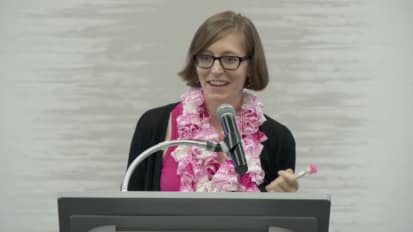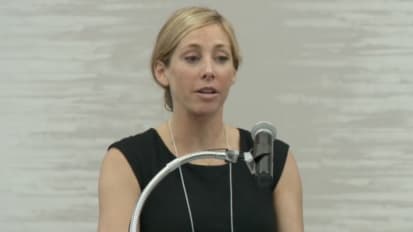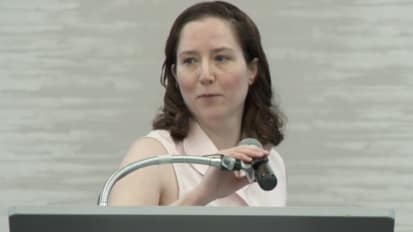Chapters
Transcript
SPEAKER 1: I'm going to touch on obesity, nutrition, genetics, new regimen chemo. It's all here and I didn't even plan it. It's very exciting. Okay, so here's the outline. Okay, I'm going to start a little bit about epidemiology, but most of the talk is going to be about what the standard approach is to triple negative breast cancer now, and where we're going in the future.
All right, so to start as a way of review, we know that there are different types of breast cancer. Clinically these are based on three markers: estrogen receptor, progesterone receptor, and HER2. The most common breast cancer that we see is ER breast cancer, which is a good thing because it also has the best prognosis. The HER2 breast cancers make up about 20%, and then the triple negative breast cancers also make up the other 20%.
You might hear, when people talk about the different types of breast cancer, people referring to the molecular subtypes as well. And so these are Luminal A, Luminal B, HER2 overexpressed, and Basal-like. And the molecular subtypes do overlap with what we see clinically in terms of ER, PR, and HER2, and how we base our treatments in the clinic, but that overlap is not 100%. And I like to make that designation because the triple negative breast cancers tend to be basal-like on the molecular level, but it isn't 100%. The ER breast cancers tend to be the luminal breast cancer subtypes. So the Luminal A and the Luminal B's tend to be the ER , and then the HER2 breast cancers tend to be the HER2 overexpressed.
So just focusing on triple negative breast cancer and what makes it different. In the first place, it tends to be a more aggressive cancer on the histologic level. So when the pathologist looks at it under the microscope it has more aggressive features, and that does translate into different behavior that we see in patients. These patients tend to be our younger patients, who are presenting with triple negative breast cancer, unfortunately. African-American women and women of African origin tend to be overrepresented among triple negative breast cancer patients, and I'll talk a little bit about that in another slide. These patients tend to present with later stage, faster growing tumors, and oftentimes we hear about something called an interval tumor. And that is a patient who had a mammogram, it was normal, and then they felt something, and then this sprang up between their annual mammogram. So that's called an interval tumor. Those tend to be triple negative as well, and that goes along with the idea that these are faster growing and more aggressive. Unfortunately, that does portend a poor prognosis with shorter survival time. Some of that is because of the nature of disease, but some of that is because we don't have treatment options yet that are as good as the treatment options that we have for the other types of breast cancer, which is certainly what we want to move toward.
The relapse rate and the relapse patterns in triple negative are also different. So this cancer tends to relapse early on in the first three years. In the years three to five, the relapse rate tends to decline. And by year eight if you haven't had a relapse, the likelihood is that you won't see a relapse. And this is in contrast to the ER breast cancers, which tend to have relapses late, even decades later. Which we heard about from Dr. [INAUDIBLE] this morning, where you are actually trying to protect people from relapses that can happen even 10 and 20 years down the line. See I even wrapped in an ER talk. You're welcome.
Okay, so this is some data from Triple Negative Breast Cancer Survival in the California Cancer Registry. So they followed 44,000 women in the state of California from 1999 to 2003 with breast cancer, all-comers, and over 6,000 had triple negative breast cancer. And what they found is at every stage survival from triple negative breast cancer was lower, and that in their cohort in California, the women with triple negative breast cancer were more likely to be African-American, Hispanic, or under the age of 40.
I don't know if you can see this, but you probably can't, because I can't either. But what this is showing is five year survival rates. Stage one. Stage two. Stage three. These lower boxes are for the triple negative breast cancers compared to all others, and then the groups are different ethnic and racial groups. And so basically what this shows, is again at stage one, stage two, and then this is a combination of stage three and four. You really do see a much shorter survival time with each stage.
In terms of epidemiology, I wanted to make a note here, because there is a lot about triple negative breast cancer epidemiology and how it may relate to survival disparities that we see in breast cancer. Particularly related to African-American and Hispanic women. This is a slide that shows different studies that have actually happened around the US and one in Africa, and some major cities: Atlanta, Philadelphia, California, in North Carolina as well, and in West Virginia. And the proportion of African-American women among the triple negative breast cancers in these cohorts ranged anywhere from 21% to 42%. And so that is not to say that only African-American women get triple negative breast cancer. That's absolutely not the case, but that they are overrepresented among triple negative patients.
So what are the risk factors for triple negative breast cancer? Well, one that we know about is obesity. And in the nutrition talk there was a little part of the slide about obesity in pre-menopausal women, and what does that have to do with breast cancer, because really it's post-menopausal. Well this is what it has to do with-- It has to do with the fact that in pre-menopausal women, obesity predisposes you to triple negative breast cancer. There was actually one study that I found really interesting, that took a group of triple negative breast cancer patients, and went back and asked them about their weight change over time, and looked at their weight change from the age of 18 to whatever age they were at the time of the study, and found that a change in BMI of over 10 kilograms per meter squared was basically doubling your risk of triple negative breast cancer.
So it's not just a matter of pre-menopausal obesity, but also what your weight does over time. So again, really important to be vigilant about fruits, vegetables, exercise, all of those good things, and trying to maintain a healthy weight over a lifetime. Lack of breastfeeding we heard about as well. That is a risk factor for developing triple negative breast cancer. Higher numbers of birth at younger ages. And then genetics. So you heard again, I'm going to say this a lot because I told you people did my job for me, so this is a good wrap up. But certainly BRCA carriers, if they do develop breast cancer are more likely to develop triple negative breast cancer. There is also a correlation between BRCA2, although it's not as strong with triple negative breast cancer, but the prevalence is up to 20%.
And then I have a lot of question marks, because as we know, any of us in the room who interact with breast cancer patients, a lot of the thought process and the worry is-- Why did I get this? Why did this happen to me?-- And oftentimes we don't know. In fact unless you have a genetic mutation, unless they're BRCA1 or 2, I can't ever say with any certainty as to why it happened.
So I'm shifting a little bit. That was my intro. I'm shifting a little bit into treatment. This is a paradigm that-- I really like this slide, because it shows where the different molecular subtypes of breast cancer lie, and how responsive they are to chemotherapy and how resistant they are to chemotherapy. So the Luminal A and the Luminal B breast cancers, which again tend to be our breast cancers which are ER PR positive, they lie on the spectrum that are actually resistant to chemotherapy, and so we know with those patients the most important thing that we can do for them are endocrine maneuvers. And a lot of the work in the patients who are on this end of the spectrum is actually identifying those patients who don't need chemotherapy, because they're early stage, and they have ER disease, and we know that we're not benefiting them with chemotherapy. And so in these patients we try to find them with other testing and then say, you know what no chemo for you. Go straight to endocrine therapy.
On the other end of the spectrum, you have those cancers which are exquisitely sensitive to chemotherapy. These are the ones that are faster growing. If you think about it chemotherapy is designed to kill actively growing cells. And so, the breast cancers which are more aggressive, more actively dividing, more actively growing, are going to be the ones that respond the best to chemotherapy. And so on this end of the spectrum, you have the Basal-like, which tend to be the triple negative breast cancers, which are sensitive to chemotherapy and independent of endocrine therapy. So the triple negative breast cancers we don't offer endocrine therapy, because their ER PR is negative, and we know they don't benefit.
Here in the middle you have the HER2 overexpressed, and this has been a really great story for medical oncologists. I hear stories of when the first Herceptin data was presented at ASCO, which was a little bit before my time. I wasn't there but I hear it was like a concert with people with lighters, and all of those things, standing up and cheering, because it was such a huge step forward in how we treat our breast cancer patients. These HER2 patients, by way of their tumor biology, have worst prognosis, had a more aggressive tumor, have worse prognosis, but with the advent of these targeted therapies with Herceptin, and now Perjeta and others, Kadcyla, [INAUDIBLE] and so on. That pretty much neutralizes that prognosis. And so, this is a great story of how finding a target in an aggressive cancer can really impact prognosis enough that we can tell people, your prognosis is actually-- you know, it kind of cancels it out because the drugs we have are so good now. And that is certainly what we want to do for the triple negative patients.
So right now the standard treatment for triple negative patients is chemotherapy alone. There are not targeted therapies for triple negative yet. Notice that I said yet. And we really feel that by getting better with the chemotherapy that we choose, and finding druggable targets, that we would like to impact triple negative as much as with HER2 and with endocrine responsive disease. Right now standard chemotherapy is anthracycline and taxane containing regimens. We heard all about neoadjuvant chemotherapy in the keynote address. In the neoadjuvant setting we do follow pathologic complete response, and so I don't even have to go into the definition because we had a good definition there. But we do look for the absence of disease in the breast and the nodes, and that gives us an idea of how effective a particular chemotherapy regimen, or targeted agent will be, in terms of treating a cancer.
And so, with anthracycline and taxane, depending on which studies you read or which series you follow, the pathologic complete response rates are anywhere from 30% to 45%. And then building on that with adding particularly platinum agents, platinum drugs, have increased the pathologic complete response rate. And so when I say platinum agents, I'm talking about both cisplatin and carboplatin. Both of these have been studied. The pathologic complete response rates have approached up to 60% when the combination of platinum chemotherapy has been added to anthracycline and taxane. This has also been studied in the metastatic setting and found to have an effect on metastatic triple negative patients as well.
So I'm going to back up just a bit, and talk about why there was even interest, in terms of adding platinum chemotherapy to anthracycline and taxane, and why that was the first thought, I guess, in terms of what to add to chemotherapy. And so, this goes back to the fact that histologically there are a lot of similarities between triple negative breast cancer and those cancers that we see in patients that have BRCA mutations. And so, it's not that they necessarily have to be BRCA mutated and then get triple negative breast cancer, it's just that when you look at a BRCA mutated cancer and a triple negative breast cancer on the histologic level, there are enough similarities that people who are smarter than I am said wait a minute, maybe if we use the same approach as we do in BRCA mutated cancers, this would work in triple negative breast cancers. And so some of the shared characteristics are that the BRCA mutated cancers do tend to be triple negative, and they have this kind of same histology where P53-- I think we heard about that in the genetics talk this morning-- with mutant P53 status on the gene expression profiling that shows us a molecular subtypes, that they tend to be basal-like.
These are the BRCA mutated cancers with high grade histology. So what this all means is that the BRCA mutated cancers are particularly sensitive to chemotherapy that causes double strand breaks, and the type of chemotherapy that does that are platinums. And so, studies first were in BRCA mutated cancers, in terms of using platinum agents, but then the observation was made-- well if the triple negative actually looks a lot like it, perhaps we should try the platinums, and the same things that we're doing for BRCA and triple negative.
Now what I find interesting, is when you read literature about triple negative breast cancer, a lot of the studies are even talking about the BRCAness in air quotes, of triple negative. So really how alike is a triple negative tumor to BRCA mutated cancers, and they're even looking at drugs that can induce BRCAness in a triple negative, and increase certain markers, so that it does become more like a BRCA mutated cancer and that they can use the same kind of strategies against it.
So what do we know so far about platinum agents? Well, the neoadjuvant trials among BRCA1 cancers showed pathologic complete response rates of up to 90%. The big caveat there is that the 90% had 10 patients in it. So it's 9 out of 10, but still 90%. That sounds pretty good. At least I told you. I didn't even have to tell you that. So that was only among BRCA1 cancers. In terms of triple negative studies, and this is not one study, this is just a conglomeration of studies. I didn't want to include all of the slides, but essentially what we have seen is anywhere from 22% path CR rates with just cisplatin, and then when you add cisplatin to chemotherapy, which includes different schedules of anthracycline and taxane, that you can get the pathologic complete response of up to 62%. In terms of metastatic triple negative breast cancer, cisplatin in combination with other chemotherapies have shown a response rate of up to 60% in metastatic patients. Cisplatin alone, 35% response rate. And some with durable responses of several years, which is actually very exciting for us in metastatic patients. And then 23% with carboplatin.
I'm going to spend a little time talking about two studies in particular that were done in the neoadjuvant setting with carboplatin. The one study is CALGB 40603, and then the second is GeparSixto. What they have in common is that they were both studies that looked at the addition of carboplatin in the neoadjuvant setting. The CALGB 40603 was all triple negative breast cancer patients with four arms. So one arm was standard anthracycline, taxane; one arm was anthracycline, taxane, carboplatin; one was anthracycline, taxane, bevacizumab, more on that later; and the last arm was carboplatin, taxane, and bevacizumab, so both together. So you had a standard arm, one platinum alone, one bev alone, and then the combination, and all of these patients also got anthracycline as well. And what the study found was that the path CR rate improved from 41% to 54%. This was in the carboplatin arm, and the three year events of free survival went from 71.6% to 76.5% in the carboplatin arm.
In the GeparSixto study, this is a German group, and this was actually for triple negative and for HER2 patients. There is about 600 patients on the whole study. About 315 I think were triple negative and the triple negative patients were treated also with taxol, anthracycline, bevacizumab, everyone got, and then plus or minus carboplatin. And essentially what they found, was in the group that had carboplatin added the path CR weight went from 37% to 53%, with a three year of right free survival of 76% to 85%.
And so, I present these studies because when you read the literature about platinum agents in triple negative breast cancer, these two are the studies that are most likely cited, because they are the largest that show us a benefit in terms of pathologic complete response in triple negative breast cancer patients.
You'll notice I mentioned bevacizumab. Bevacizumab is an angiogenic agent which basically blocks vascularization. So it blocks the tumor getting blood vessel so that it continues to grow. The issue with bevacizumab in the first study, was that the single agent arm actually didn't show significance, the double agent arm had the most significance, but also had the worst risk of patients not completing all of their chemotherapy, and more toxicity. And so the other part of bevacizumab, which is way beyond the scope of what I'm talking about, but some of you may know, is that it was approved, and it wasn't approved, and right now it's not approved for breast cancer and so the long is short of the story is that we're not actively using it in breast cancer. Whether or not we'll have more evidence that it might be good for triple negative breast cancer remains to be seen, but for now definitely the take away on these is that carboplatin does increase the pathologic complete response rate.
This gets a little hairy, because the way that the carboplatin was dosed was different in the two trials. In one of the trials they actually had to dose reduce the weekly carboplatin, and so there is a lot of extra toxicity there. And so the question is, if we want to use this in clinic now, are you going to use every three week regimen? Are you going to use every week regimen? How are you going to manage the toxicities? These are some of the issues now. What was interesting in the GeparSixto study was, I mentioned to you this idea of BRCA and BRCAness, and how definitely the carboplatins tend to benefit more of the patients who are more like BRCA, but what they found was the benefit was found in their BRCA wild type and mutated patients. And in fact the benefit was actually most significant amongst the wild type patients. So again, this idea that triple negative is very much like BRCA, and having an effect there without needing to have a BRCA mutation.
So the next slide-- the next few slides I will talk about briefly, are targeted therapies. And so what I just covered are chemotherapy. Again, the standard is anthracycline and taxane. There's a lot of interest in adding carboplatin as a chemotherapy agent. But right now I'm switching focus into how do we get to those targeted therapies that Dr. [INAUDIBLE] talked about. Dr. Thomas, even in the first talk today, mentioned immunotherapy, and maybe there's a role for immunotherapy in triple negative breast cancer. So the most promising agent so far, in terms of targeted therapies for triple negative breast cancer, is this class of drugs called parp inhibitors. Parp inhibitors are useful in BRCA mutated patients as well. So again, you're hearing the same thing. BRCA-like, BRCAness, whatever you want to call it, is the similarities between triple negative breast cancer and BRCA.
So I love this slide. I didn't draw it. I wish I had because I love it so much. But to me it just really shows what we're doing with chemotherapy and how we're trying to kill tumor cells, which as a medical oncologist, makes my little heart go pitter pat. Okay, so basically what we're doing is inciting DNA damage. Okay, so in this case we're doing it with platinum chemotherapy, right? So we give the platinum agent. We cause damage to the DNA, and what we want is for the cell to die. Die die die.
Okay, well a normal cell has two ways to repair itself when it gets any damage-- from radiation, from chemotherapy, from whatever. Two different ways to do this: basic [INAUDIBLE] repair is one way to do it, homologous recombination is another. So what happens if you're a normal healthy cell, just walking around living your life? You get damaged, you have two different ways to repair yourself, and you go on to live another day, and we're all happy. Okay, if you are a cancer cell and you have BRCA mutation, what the BRCA mutation does is knocks out the homologous recombination pathway.
So already you're down one way to save yourself, but you still have this pathway intact, so you go on to live another day. Alright, if you're deficient in parp-- remember this is parp inhibitors-- if we block parp, what part does is act on this other pathway basic [INAUDIBLE] repair. So if you're blocked here but you still have this open, you get to live another day. Now this last part is what happens if you have a BRCA mutated cell that's already knocked out this pathway, and then you block this with a parp inhibitor, and then you damage the cell with some chemo, and then it dies. Die Die Die, which is what we like, which is what I like as a medical oncologist. So that's how parp inhibitors work.
So in the metastatic setting, there was a single agency study of olaparib, which is an oral pill, oral parp inhibitor in BRCA patients. 54 patients and a response rate of up to 41% in that patient population. In combination with some chemotherapy, in this case temozolomide, with eight patients who had BRCA 1 and 2 mutations, the overall response rate went up up to 37% and the clinical benefit rate was up to 62%. So, you may have noticed that there's not much in the way of inducing that initial damage, because the BRCA mutated patients are already down one of their pathways. When the researchers who designed the study, this is an [INAUDIBLE] study, looked at how to best give parp inhibitors, the question was what chemotherapy backbone are you going to use to get that initial damage on the cell, in combination with the parp inhibitor. So their phase two was in 123 triple negative metastatic breast cancer patients.
They found an overall response rate of 32% versus 52%, and an overall survival advantage of seven months versus 12.3 months. And here is the survival curve, and I was at this meeting and we all went nuts, because this was the first time we saw metastatic it benefit in overall survival in the metastatic triple negative breast cancer setting. So everyone was excited. I was excited. They did the confirmatory phase three study. 519 patients.
Basically their co-primary endpoints were overall survival, progression free survival, and it was a bust. Bust bust bust. No significant difference in overall survival and no significant difference in progression free survival. Although, the overall survival in the study was actually 11 months, which is more than you would have expected, but at any rate it was a negative study. They did note that there was an increase progression free survival in patients who were on their second or third line of therapy. And so, we were all bummed. I was bummed. Everybody was bummed.
And then the discussion starts of, why didn't this work? If the phase two study worked, why didn't the phase 3 study work? And there are a few hypotheses about that. The first is that there's actually heterogeneity within triple negative breast cancer, and I will talk about that in a minute, but I promise you that I don't have that many slides left, but I'm going to get to that. So there are different types of triple negative breast cancer. The second question was, was it the right chemotherapy backbone? Could we do better in terms of picking what we're going to pair the parp inhibitor with? And then, the lack of parp inhibition. So as it turned out, this particular agent was an IV drug that didn't actually hit its target.
This did not dampen the enthusiasm for parp inhibitors then, because really when the issue became that this wasn't a really efficacious parp inhibitor, there were studies that continued on. And I have one in Philadelphia, where agents that were true parp inhibitors that did hit the target, were continued in triple negative breast cancer. And this is one piece of evidence that we had recently that came out by [INAUDIBLE] in the New England Journal from the I-SPY 2 trial. And the I-SPY 2 trial is being conducted at a variety of centers around the country, and what they are doing is adding to a standard backbone of chemotherapy of taxol specific targeted agents, depending on biomarker signatures.
And it's a very sophisticated study, but the takeaway of this is that the first result that they released from the study, was in the triple negative patients with taxol and veliparib, which is an oral parp inhibitor which does in fact hit the target of the parp enzyme. That in combination with carboplatin [INAUDIBLE] toxin, which we've talked about before. In the triple negative group, the path CR rate was up to 51% versus 26% in the control group. And the point of this-- the way that they're doing I-SPY 2, is called an adaptive randomization, and what they're doing is graduating certain drugs out of phase 2 into phase 3. This is an effort to get drugs faster for approval to those patients who can benefit the most. So this was the first drug that they have graduated and recommended for phase 3 is this inhibitor veliparib in combination with carboplatin. So exactly what we talked about in the slides previously, with a success rate, they think, in 300 patients of around 88%.
Okay, so these last few slides are just a few to touch on what I see in terms of where we're going in identifying other targeted therapies. So certainly the most work so far has been done in the parp inhibitors, but I think what we're going to see more of now, is looking at targets by triple negative type. And so, I mentioned a few slides back that there's heterogeneity even within triple negative breast cancer patients, and indeed, there are different molecular subtypes of triple negative breast cancer patients. Just like there are different molecular subtypes of allcomers of breast cancer.
So this thing it just keeps unraveling, which is fascinating. But the triple negative subtypes right now, the immunomodulatory type is a subtype that is enriched in immune cell processes. More on that in a second, but think immunotherapy, from the slides before. The BL1 and BL2 are the bays basal-like. These have a [INAUDIBLE] 67, or higher growing and have more cell cycle dysregulation. This is unclassified. In The M and the MSL are mesenchymal and mesenchymal stem-like. And those subtypes tend to have more dysregulation in terms of cell mutility and interaction with extracellular matrix.
And then the luminal androgen receptor. So this is a subtype that is not responsive to chemotherapy, and is hormonally driven, and expresses a receptor for androgen. Right, who said that? Exactly. So the androgen receptor subtype, it lends itself to-- not an easy way to study it, but we already have drugs for it, and the drugs that we use are in prostate cancer. So for prostate cancer there are already androgen receptor inhibitors that are in use for metastatic prostate cancer patients. Enzalutamide being one of them. With the recognition that there is a subtype of triple negative breast cancer that over expresses this receptor, there have been studies amongst metastatic triple negative breast cancer patients in looking at enzalutamide, a prostate cancer drug, which shows a benefit rate of around 39% in these patients who have positive staining for androgen receptor. Progression free survival of 16 weeks among AR patients compared to eight weeks among our negative patients, and then half of the study population of 118 patients, were actually androgen receptor positive. So again, and we see it in the clinic, we have patients that we give all of our chemotherapy to, our best chemotherapy. And they blow through it and we go, what is going on? Well maybe this is what's going on. Maybe they're in the subtype that actually doesn't respond well to chemotherapy and needs more of a hormonal target.
This is just a flavor of-- I did a search on what's open in the NCI just to give you just a little view of this, but here are some which are targeted to the androgen receptor. And then here in Dr. [INAUDIBLE] talk, he mentioned some of these PI3 kinase inhibitors, AKT inhibitors, EGFR was mentioned. In the interest of time I wasn't going to go into all of these, but there is a lot of interest in terms of targeted therapies.
This is the last thing I'm going to show. This is immunotherapy, and this has been mentioned as well. Dr. Thomas this morning and Dr. [INAUDIBLE] So immunotherapy has really changed the landscape for certain tumors, melanoma, and lung cancer. I'm jealous, because these are the new sexy drugs as Dr. Thomas says, and we don't have any of these yet that have shown great efficacy for breast cancer. So I'm jealous, because I want all the best drugs for my patients, but the way that immunotherapy works is-- just briefly, this is a T-cell, which is primed to attack cancer tumor cells. This is a tumor cell. The tumor cell has something called a PD1 ligand, which can bind to a receptor on the T-cell and cause the T-cell not to do his job. So it basically has a way to shut the T-cell down so the T-cell doesn't attack it and kill it. What the immunotherapies are doing, is blocking this interaction.
So these are drugs which take away the tumors ability to shut off the T-cell, so the T-cell can go on about his business and do his job, which is attacking the cancer. And this has made a huge improvement-- like I said melanoma, lung cancer, bladder cancer-- and if you remember there's a triple negative subtype which is called immunomodulatory, which has over expression of infiltrating lymphocytes, which is immune cells. And there have been some studies. There was a phase one study of pembrolizumab, that's my last slide, that showed a response rate of about 18%. So not great, but it's there. And other studies that have shown expression of these antibodies in the triple negative. So more on that to come, I think.
This is just a list to show you all of the immunotherapies in triple negative breast cancer that are open. So in conclusion, I didn't do too bad. Yeah, I did. Okay, in conclusion triple negative carries the worst prognosis among breast cancer patients. There's a role of triple negative and survival disparities. Standard treatment is anthracycline and taxane based chemo. We talked about the role for platinum chemotherapy, targeted therapies by triple negative subtypes, development of immunotherapy among triple negative, and the need for clinical participation. We do have a new triple negative trial open now. That's looking at platinum agents in the adjuvant setting. So plug for that. Thank you, have a good week.
Tiffany Avery, MD, presents her topic 'Updates In Triple Negative Breast Cancer Treatment'.
Related Videos





